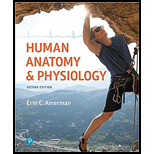
Which of the following are considered parts of the axial skeleton? (Circle all that apply.)
a. Pectoral girdle
b. Lower limb
c. Skull
d. Vertebral column
e. Pelvic girdle
f. Thoracic cage
Introduction:
The skeletal system provides the framework for the body. The human skeletonconsists of 270 bones at the time of birth, but the number decreases to 206 inadulthood because of the fusion of some bones. The human skeletal system is dividedinto two parts: axial skeleton, whichmaintainsan upright posture of the human body, and appendicular skeleton, whichconsists of limbs and girdles. Appendicular skeleton helps in the movement of the body.
Answer to Problem 1CYR
Correct answer:
The parts of the axial skeleton are skull, vertebral column, andthoracic cage.
Explanation of Solution
Justification/explanationfor the correct answer:
Options (c), (d), and (f) areskull, vertebral column, as well as thoracic cage, respectively. The axialskeleton consists of 80 bones. The skull is composed of 22 bones, out of which eightare cranial bones and 14 are facial bones, whichmake the framework for the face. The vertebral column is composed of 33 bones, out of which 24 bonessurround the spinal cord, and two inferior bones, namely, the sacrum (5 fused vertebrae) and coccyx (4 fused vertebrae), are fused with each other. The thoracic cage has 12 pairs of ribs, whichprotect the lungs and heart. Hence, options (c), (d), and (f) are correct.
Explanation for the incorrect answers:
Option (a) is pectoral girdle. Pectoral girdle surrounds and supports the upper limbs. Itcontains two bones: clavicle and scapula, and is not a part of the axial skeleton. So, it is an incorrect option.
Option (b) is lower limb. The lower limb consists of three parts, which are femur(thigh), tibia, and fibula (leg), and foot bone comprising tarsals, metatarsals, and phalanges. Theselimbs hold the upper part of the body. Theyhelp in locomotion and are not a part of the axial skeleton. So, it is an incorrect option.
Option (e) is pelvic girdle. Pelvic girdle consists of two pelvic bones and the sacrum. It supports the pectoral girdle. The pelvic bone consists of three fused bones, namely, ilium, ischium, and pubis. It is also not apart of the axial skeleton. So, it is an incorrect option.
Hence, options (a), (b), and (e) are incorrect.
Thus, it can be concluded that the skeletal system of a humancomprisestwo parts. The parts of the axial skeletonare skull, vertebral column, and thoracic cage. So, options (c), (d), and (f) are correct.
Want to see more full solutions like this?
Chapter 7 Solutions
HUMAN ANATOMY+PHYSIOLOGY-PACKAGE
- This question has multiple parts (A, B & C), and under the subject of Nutrition. Thank you!arrow_forwardCalculate the CFU/ml of a urine sample if 138 E. coli colonies were counted on a Nutrient Agar Plate when0.5 mls were plated on the NA plate from a 10-9 dilution tube. You must highlight and express your answerin scientific notatioarrow_forwardDon't copy off the other answer if there is anyarrow_forward
- Use the following information to answer the question(s) below. Martin Wikelski and L. Michael Romero (Body size, performance and fitness in Galápagos marine iguanas, Integrative and Comparative Biology 43 [2003]:376-86) measured the snout-to-vent (anus) length of Galápagos marine iguanas and observed the percent survival of different-sized animals, all of the same age. The graph shows the log snout-vent length (SVL, a measure of overall body size) plotted against the percent survival of these different size classes for males and females. Survival (%) 100- 80- 60- 40- 20- 0+ 1.9 T 2 2.1 2.2 2.3 2.4 2.5 2.6 2.7 Log SVL (mm) 19) Examine the figure above. What type of selection for body size appears to be occurring in these marine iguanas? A) directional selection B) stabilizing selection C) disruptive selection D) You cannot determine the type of selection from the above information. 3arrow_forward24) Use the following information to answer the question below. Researchers studying a small milkweed population note that some plants produce a toxin and other plants do not. They identify the gene responsible for toxin production. The dominant allele (T) codes for an enzyme that makes the toxin, and the recessive allele (t) codes for a nonfunctional enzyme that cannot produce the toxin. Heterozygotes produce an intermediate amount of toxin. The genotypes of all individuals in the population are determined (see table) and used to determine the actual allele frequencies in the population. TT 0.49 Tt 0.42 tt 0.09 Refer to the table above. Is this population in Hardy-Weinberg equilibrium? A) Yes. C) No; there are more homozygotes than expected. B) No; there are more heterozygotes than expected. D) It is impossible to tell.arrow_forward30) A B CDEFG Refer to the accompanying figure. Which of the following forms a monophyletic group? A) A, B, C, and D B) C and D C) D, E, and F D) E, F, and Garrow_forward
 Concepts of BiologyBiologyISBN:9781938168116Author:Samantha Fowler, Rebecca Roush, James WisePublisher:OpenStax College
Concepts of BiologyBiologyISBN:9781938168116Author:Samantha Fowler, Rebecca Roush, James WisePublisher:OpenStax College- Basic Clinical Lab Competencies for Respiratory C...NursingISBN:9781285244662Author:WhitePublisher:Cengage
 Medical Terminology for Health Professions, Spira...Health & NutritionISBN:9781305634350Author:Ann Ehrlich, Carol L. Schroeder, Laura Ehrlich, Katrina A. SchroederPublisher:Cengage Learning
Medical Terminology for Health Professions, Spira...Health & NutritionISBN:9781305634350Author:Ann Ehrlich, Carol L. Schroeder, Laura Ehrlich, Katrina A. SchroederPublisher:Cengage Learning Human Biology (MindTap Course List)BiologyISBN:9781305112100Author:Cecie Starr, Beverly McMillanPublisher:Cengage Learning
Human Biology (MindTap Course List)BiologyISBN:9781305112100Author:Cecie Starr, Beverly McMillanPublisher:Cengage Learning





